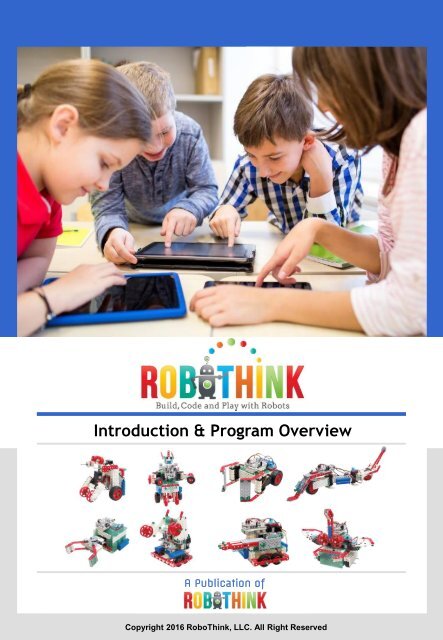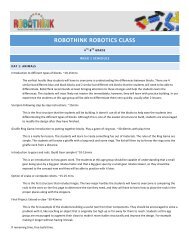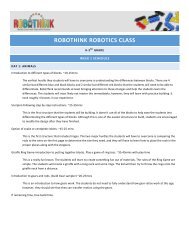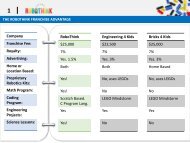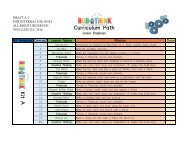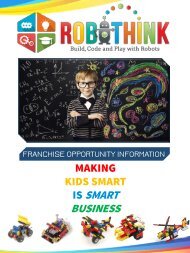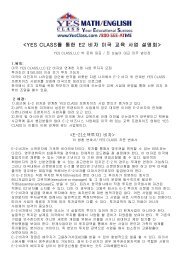robothink quick program guide
You also want an ePaper? Increase the reach of your titles
YUMPU automatically turns print PDFs into web optimized ePapers that Google loves.
Introduction & Program Overview<br />
A Publication of<br />
Copyright 2016 RoboThink, LLC. All Right Reserved<br />
0
WELCOME!<br />
To Our Valued Parents and Educators,<br />
Welcome to RoboThink! RoboThink is an exciting new STEM<br />
(science, technology, engineering and mathematics) <strong>program</strong> for<br />
students in elementary, middle and high school. Our learning<br />
<strong>program</strong> uses a proprietary robotics learning system to teach<br />
students how to build robots and how to code. Not only that, we also<br />
have fun and exciting engineering projects where students learn<br />
about aeronautics, 3-D printing, virtual reality, and much, much more!<br />
Our unique pedagogy and approach in our robotics kits and teaching<br />
methods are designed to inspire and foster creative and higher level<br />
thinking abilities as well as make robotics and coding accessible for<br />
students of all ages.<br />
In this <strong>guide</strong>, you will become familiar with why robotics education<br />
will be an important part of STEM and the innovative RoboThink<br />
STEM robotics <strong>program</strong>.<br />
We look forward to working with you as an educator and partner to<br />
inspire the next generation of engineers to contribute to America’s<br />
bright future.<br />
Sincerely,<br />
The RoboThink Team<br />
1
I<br />
Introduction<br />
Introduction<br />
1. RoboThink Mission Statement<br />
1. The mission of RoboThink is to provide an engaging<br />
and effective STEM education <strong>program</strong> in the US.<br />
RoboThink believes in student-oriented education<br />
and learning environment. We are committed to<br />
meeting the needs of students in a creative and<br />
innovative fashion.<br />
2. RoboThink is encouraging our students, the future<br />
of the world, to think, hope and dream. We believe<br />
children can excel if given the proper tools,<br />
guidance and taught in the right environment.<br />
2
I<br />
Introduction<br />
2. Why Robot Education?<br />
1<br />
2<br />
• More and more countries are going out of their way to enhance<br />
knowledge and competitive power by offering Science and<br />
Technology courses in classrooms, putting robotics technology<br />
at the core. (Japan, South Korea, China, India, Singapore, etc.)<br />
• A human-robot coexistence society is approaching and will<br />
spawn a whole new industry as a “next-gen” business. This<br />
motivates parents to keep their children exposed to robotics<br />
education.<br />
Introduction<br />
3<br />
• Robotics is interesting for students! Robotics can engage<br />
otherwise uninterested students into the world of STEM courses.<br />
4<br />
• Even today, Robotics is uneasy to access and understand for<br />
most students. RoboThink bridges that gap by bringing an<br />
easy to use and flexible robotics kits just for students. With<br />
a leveled curriculum, students of different ages and skills can<br />
begin to explore the exciting world of robotics and coding.<br />
3
I<br />
Introduction Introduction & Philosophy<br />
Robotics: An<br />
Interdisciplinary<br />
Approach to<br />
STEM Education<br />
• RoboThink is not just about building robots. Students<br />
must draw upon their critical thinking, problem solving<br />
and visual spatial abilities to work with our kits.<br />
Students are also encouraged to think creatively and<br />
use their imagination when asked to build their own<br />
robots.<br />
Students also learn relevant coding principles<br />
applicable to real life world (C Programming Language)<br />
4
II<br />
<strong>program</strong> Overview<br />
3. Program Introduction<br />
Features of the RoboThink Program<br />
1. RoboThink is a STEM Program<br />
You probably have heard of the big push for STEM (Science, Technology,<br />
Engineering and Math) subjects in public schools. This is the result of an<br />
increasing need for engineers and <strong>program</strong>mers in the global 21 st century<br />
economy. RoboThink is a development <strong>program</strong> designed to inspire students<br />
to explore the STEM world. Our <strong>program</strong> utilizes robotics, something many<br />
students are fond of, to teach students how to build robots and how to code.<br />
We also offer fun and exciting engineering projects that students choose<br />
according to their interests such as:<br />
• Aeronautics<br />
• Electric Circuitry<br />
• Civil Engineering<br />
• Mechanical Engineering<br />
• Marine Engineering<br />
<strong>program</strong> Overview<br />
By exposing students to the exciting world of robotics and an easy to use<br />
coding environment, we hope to develop our students’ thinking abilities as<br />
well as inspire them to choose a career path in engineering.<br />
5
II<br />
<strong>program</strong> Overview<br />
4. Program Introduction cont.<br />
2. RoboThink Uses Proprietary Materials<br />
Other robotics and engineering <strong>program</strong>s uses LEGOs to teach robotics and<br />
coding. The problem is that LEGOs were never designed to be used as<br />
instructional materials and have limitations in what can be built. RoboThink<br />
uses proprietary robotics kits and teaching methods specifically designed<br />
with the aid of child development experts and Montessori teachers that foster<br />
and develop:<br />
• Critical Thinking<br />
• Creative Thinking<br />
• Visual Spatial Skills<br />
• Problem Solving Skills<br />
<strong>program</strong> Overview<br />
Our robotics blocks and parts are three dimensional (they attach on all 6 faces)<br />
helping students to develop mental imaging and visual spatial skills. Because<br />
they are three dimensional, more shapes and figures can be built. Our kits<br />
also include: DC & Servo Motors, IR Sensors, Light Sensors, Touch Sensors,<br />
gears, wheels, axles & axle connectors.<br />
6
II<br />
<strong>program</strong> Overview<br />
4. Program Introduction cont.<br />
2. RoboThink Teaches Relevant Coding<br />
Other robotics and engineering <strong>program</strong>s uses LEGO Mindstorm kits to teach<br />
students how to code. The main problem with this is that the coding<br />
principles of Mindstorm <strong>program</strong>s do not apply to actual real life <strong>program</strong>ming<br />
languages.<br />
<strong>program</strong> Overview<br />
RoboThink Main Board<br />
RoboThink uses an open-source Arduino platform at the heart of our Robot<br />
Programming Board. The main advantage of using an open-source platform<br />
such as Arduino is that students learn how to code in the C <strong>program</strong>ming<br />
language, one of the main <strong>program</strong>ming languages used by developers<br />
around the world. The coding principles students learn with our boards will<br />
remain relevant, long after they have completed our <strong>program</strong>.<br />
7
II<br />
<strong>program</strong> Overview<br />
<strong>program</strong> Overview<br />
4. Program Introduction cont.<br />
3. RoboThink Makes Coding Easy<br />
RoboThink also uses a customized version of Scratch, an MIT developed<br />
coding <strong>program</strong> that allows students to code by dragging and dropping<br />
different shapes that represent different code.<br />
By using a easy to use coding <strong>program</strong>, students who have never coded<br />
before can learn how to code without learning the technicalities of writing out<br />
line code.<br />
By combining robotics and coding, students will be more engaged by seeing a<br />
physical manifestation of their <strong>program</strong>s.<br />
8
II<br />
<strong>program</strong> Overview<br />
5. Program Introduction cont.<br />
3. RoboThink is a Flexible Program<br />
Our <strong>program</strong> is flexible to meet the needs and wants of educators. Whether in<br />
a classroom, camp, after-school, etc., we can adjust the depth and length of<br />
the RoboThink <strong>program</strong> to fit space and time constraints.<br />
RoboThink<br />
<strong>program</strong> Overview<br />
Class<br />
After School<br />
Extra-<br />
Curricular<br />
Summer &<br />
Winter<br />
Camps<br />
And more!<br />
9
IV II<br />
The <strong>program</strong> RoboThink Overview Way<br />
2. Age-Groups<br />
Elementary Middle School High School<br />
College<br />
(In Development)<br />
• Using<br />
RoboThink blocks<br />
to build shapes,<br />
characters,<br />
scenery and<br />
objects.<br />
•Develop spatial<br />
sense<br />
•Use Scratch Jr. to<br />
learn early<br />
principles of how<br />
coding works<br />
• Begin to learn<br />
principles of<br />
gears, motors and<br />
sensors.<br />
• Use gears,<br />
motors and<br />
sensors to<br />
build more<br />
complex<br />
robots.<br />
• Begin to use<br />
RoboThink<br />
Scratch<br />
<strong>program</strong> to<br />
begin learning<br />
principles of<br />
code<br />
• Engage in<br />
robotics<br />
competitions<br />
• Use gears,<br />
motors and<br />
sensors to build<br />
more complex<br />
robots.<br />
• Use RoboThink<br />
Scratch <strong>program</strong><br />
to learn<br />
principles of<br />
code.<br />
• Continue to use<br />
Scratch <strong>program</strong><br />
to create more<br />
complex robots<br />
that respond to<br />
environment<br />
using sensors<br />
• Engage in<br />
robotics<br />
competitions<br />
• Use humanoid<br />
robots and<br />
advanced<br />
<strong>program</strong>ming<br />
languages.<br />
<strong>program</strong> Overview<br />
10
III<br />
<strong>program</strong> Instruction Overview<br />
3. Learning Cycle in Detail<br />
Recommended Learning Cycle<br />
Exchanging goodbyes<br />
Summary of<br />
this week’s<br />
work / Preview<br />
of next week’s<br />
robots<br />
After<br />
completion,<br />
allow students<br />
to make design<br />
changes to<br />
robots<br />
END<br />
Wrapping up<br />
Preparation<br />
for class<br />
Typical Class Time<br />
1:30 Hours<br />
Building Time<br />
START<br />
Starting<br />
class<br />
Greeting<br />
Getting ready<br />
for today’s<br />
engineering<br />
lesson<br />
Go over<br />
today’s<br />
mission/obje<br />
ctives and<br />
begin<br />
If the student<br />
didn’t complete<br />
last class’s<br />
robot, they<br />
should finish<br />
that first<br />
<strong>program</strong> Overview<br />
Student<br />
begins work<br />
on his robot<br />
Teaching the<br />
main science<br />
concepts for this<br />
week's lesson<br />
11
Notes<br />
Notes<br />
12
A Publication of<br />
RoboThink Introduction & Program Overview<br />
Copyright RoboThink, LLC. 2016 All Rights Reserved<br />
This data is designed to help you better understand the RoboThink Program<br />
and has been developed with an accredited research institute.<br />
Version NA-A2<br />
13


